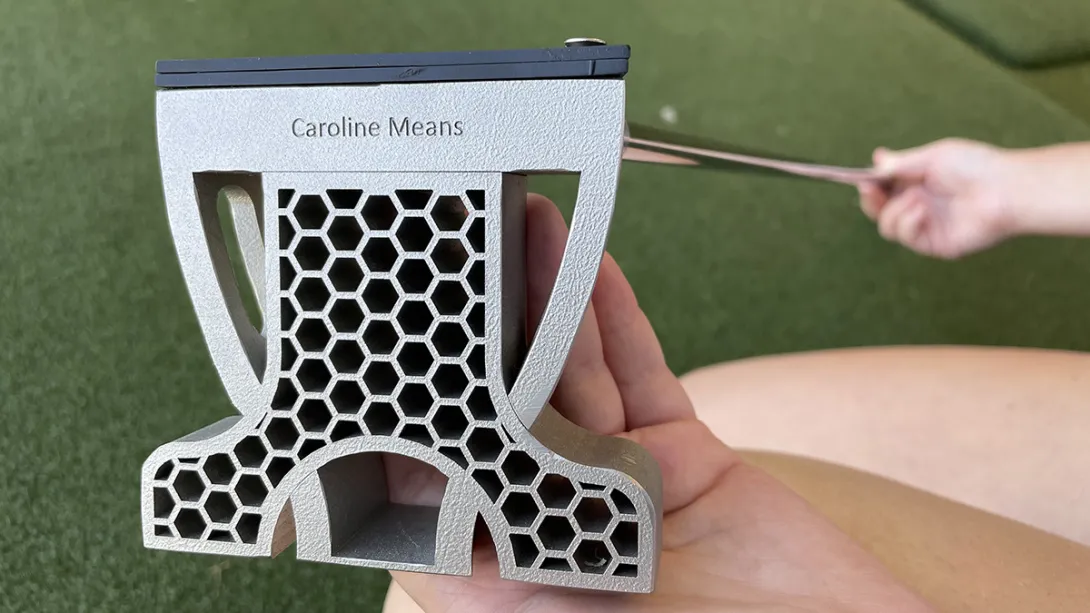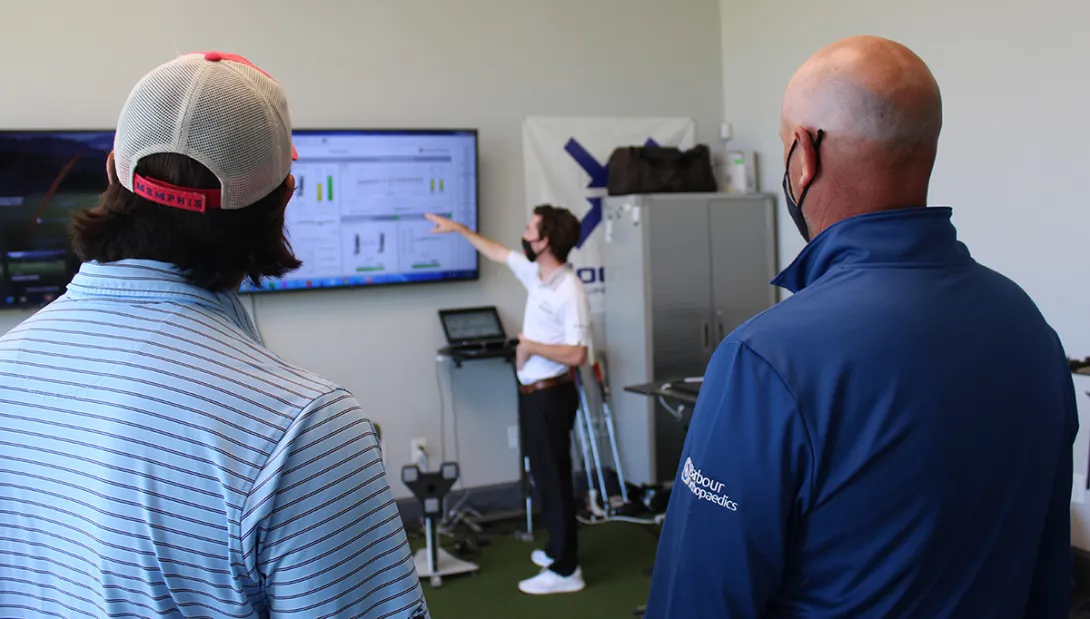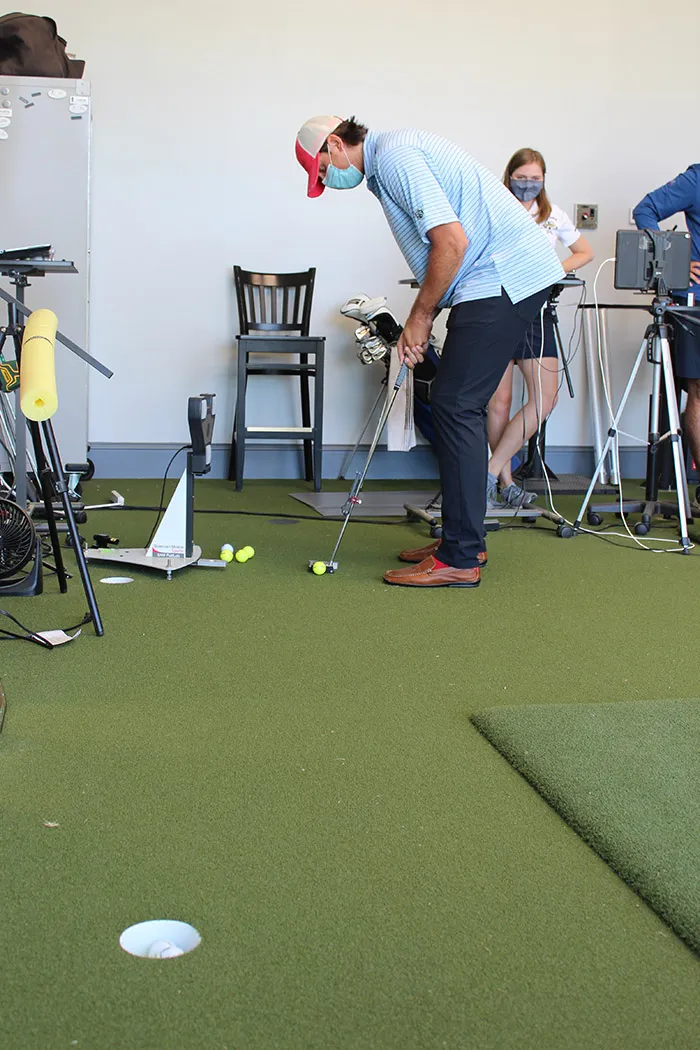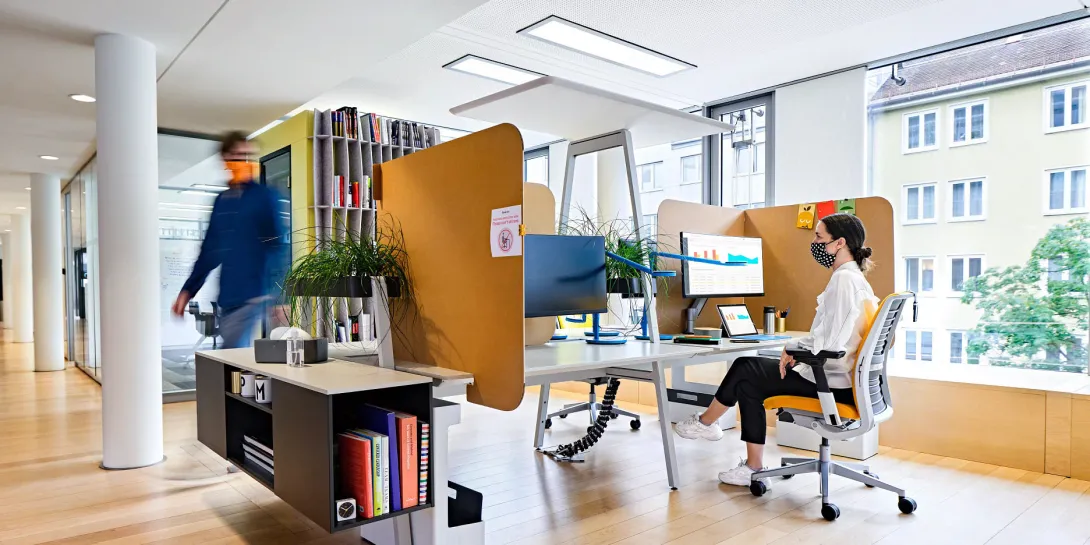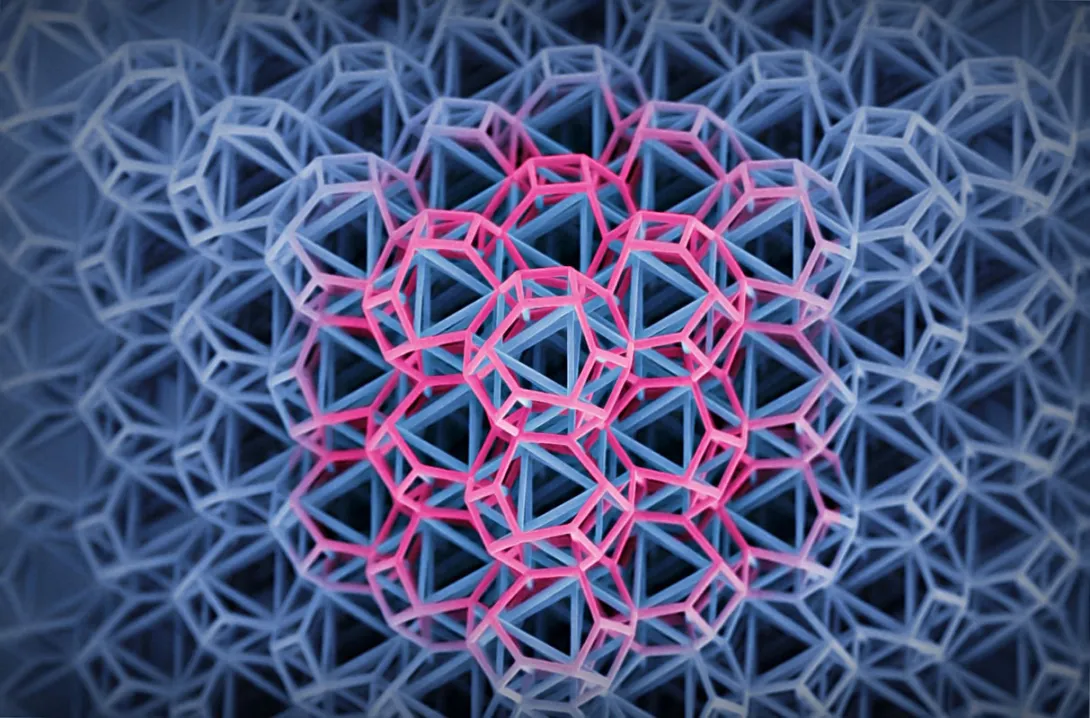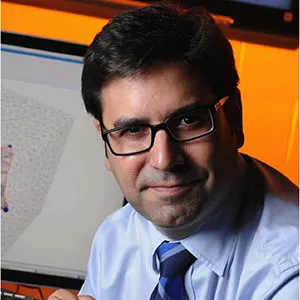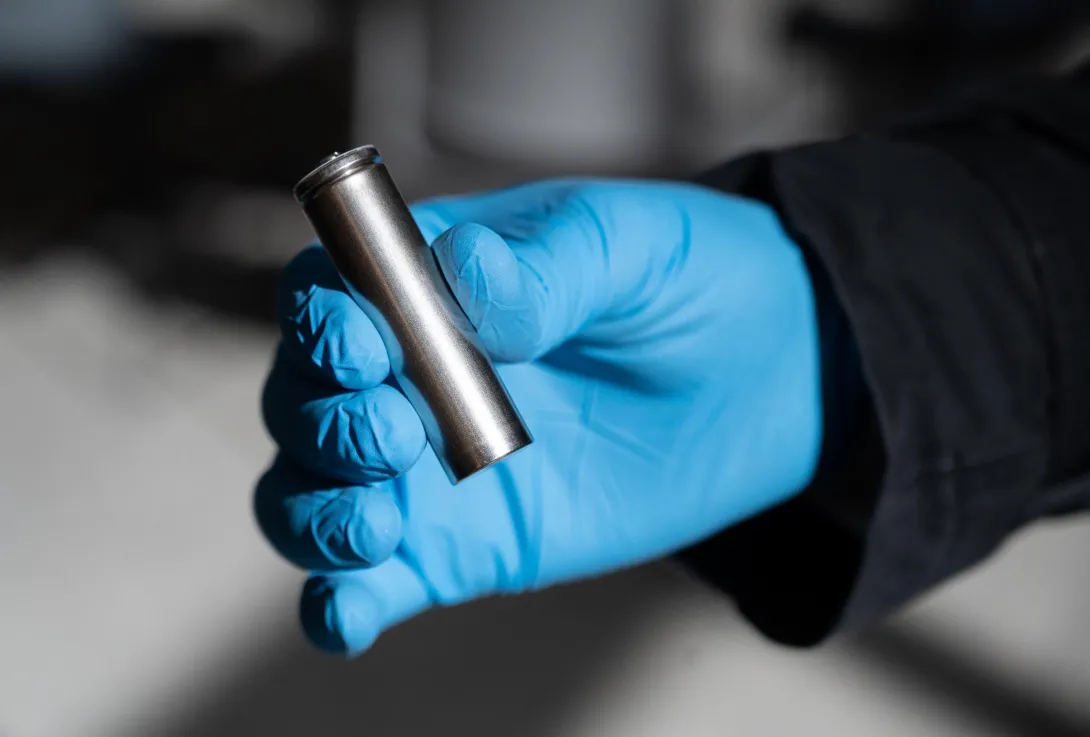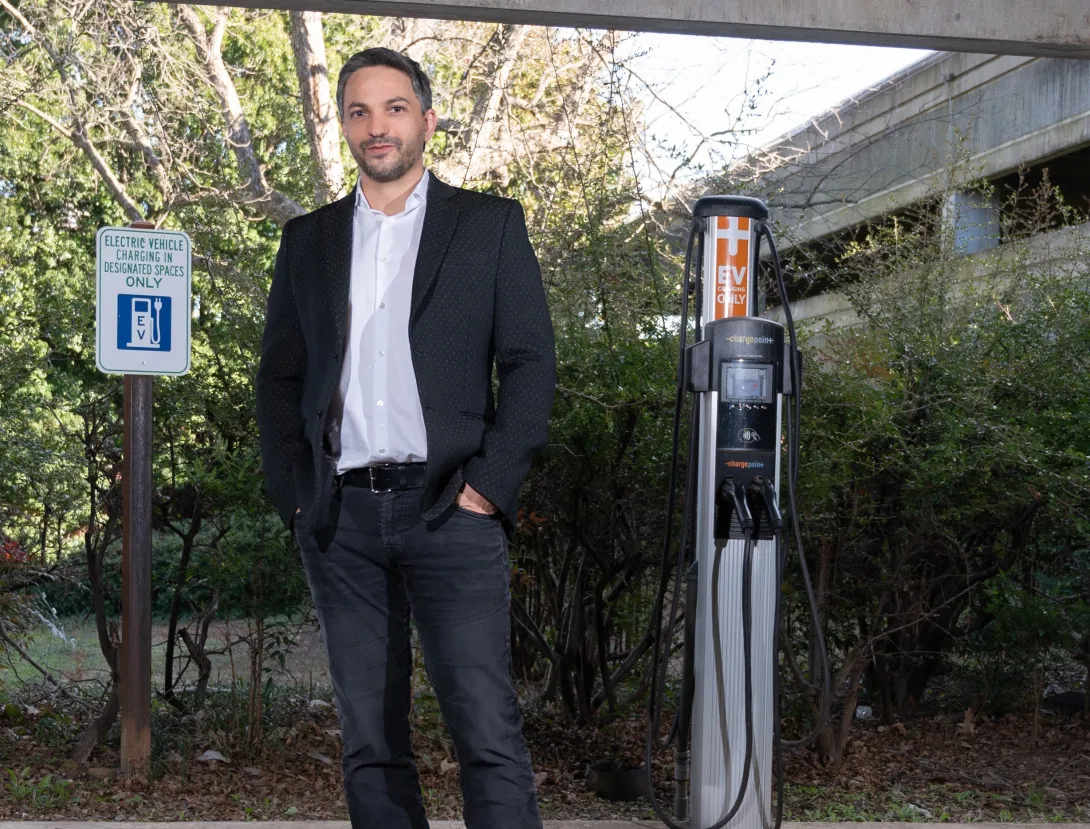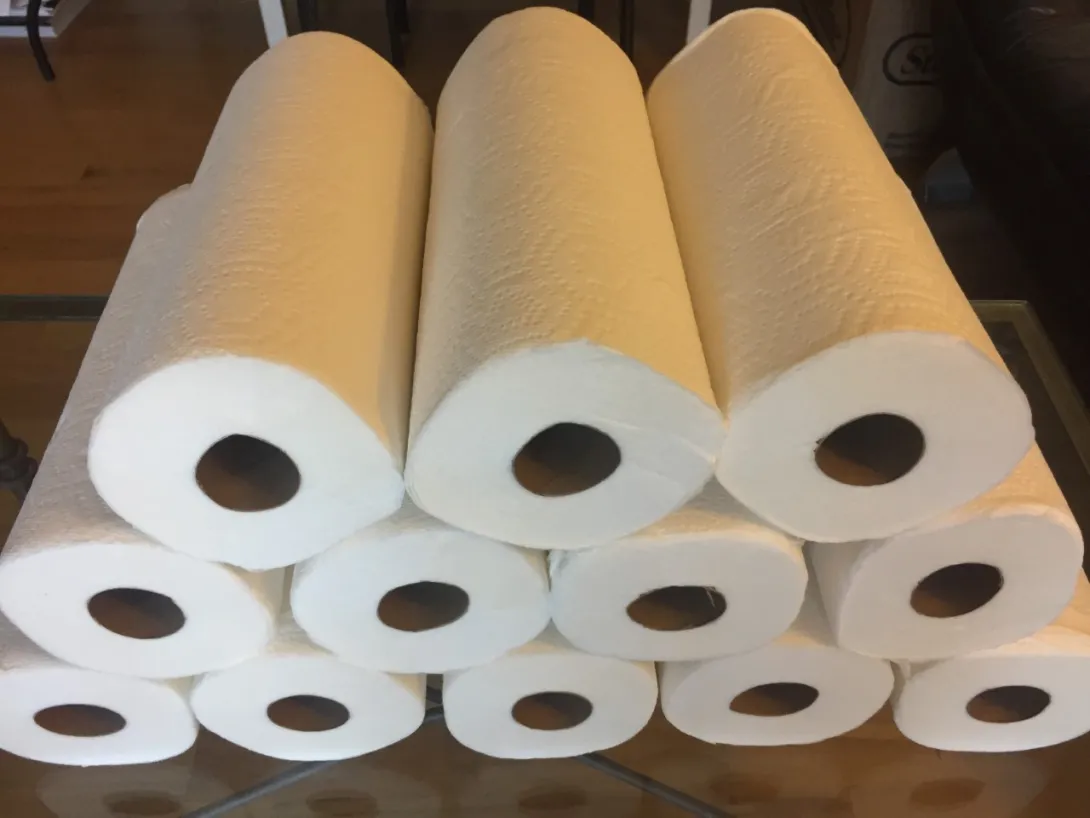Jul. 30, 2021
From Washington D.C., the Brookings Institute recently convened a virtual panel of manufacturing experts that included Ben Wang, executive director of the Georgia Tech Manufacturing Institute. Wang holds the Gwaltney Chair in Manufacturing Systems and is a professor both in the Stewart School of Industrial & Systems Engineering, and School of Materials Science and Engineering. He served as the previous chair of the National Materials and Manufacturing Board.
The panel’s topic: “Can the Biden Administration Improve the Manufacturing Sector?”
Other panelists included: David Cicilline, member of the U.S. House of Representatives; Monica Gorman, deputy assistant secretary, manufacturing industry & analysis, U.S. Department of Commerce; Elisabeth Reynolds, special assistant to the President for manufacturing and economic development, National Economic Council, the White House; Darrell West, vice president and director governance studies, the Brookings Institution; and John Hazen White, Jr., executive chairman, Taco Family of Companies Trustee, the Brookings Institution.
During the panel’s second session, Wang emphasized, “advanced manufacturing is foundational to our [nation’s] economic prosperity, resilience and the national security.” He was previously involved with President Obama administration’s advanced manufacturing partnership from 2011 to 2013.
“Building a strong manufacturing base in the U.S. is a national imperative,” said Wang. “We know that technology-based innovation is the dominant driver of economic growth in the 21st century. Our national security, standard of living, and rebuilding the middle class in our society all depends on a strong globally competitive manufacturing base.”
Wang stressed the need to have a vibrant innovation value chain tightly coupled with a strong manufacturing ecosystem. “We cannot separate innovation from manufacturing,” said Wang.
“Some policymakers believed that we could continue to innovate and leave manufacturing to other nations. As it turned out, not only did we lose our ability to produce high tech products, we began to lose our ability to innovate.”
“If we want to compete well globally, we must maintain both the technological innovation leadership and advance manufacturing leadership [in the United States],” said Wang.
The need was also stressed to support small and medium-sized manufacturers who contribute to the nation’s supply chain and overall GDP in a significant way, but lack resources to evaluate and adopt new, state of the art manufacturing technologies.
National and state Manufacturing Extension Partnerships (MEP) can play a critical role in helping these smaller entities with technology adoption.
According to Wang, regional ecosystem actors must work together to identify common manufacturing challenges and common opportunities. And then co-innovate around those common challenges and opportunities. This type of regional approach will push local companies to rethink how they should interact with one another and help ensure that benefits are shared by all.
Ben Wang’s entire presentation and the full panel discussion which was sponsored and moderated by the Brookings Institution can be found here.
News Contact
Walter Rich
Jul. 20, 2021
According to Chelsea White, professor in the Georgia Tech Manufacturing Institute, “supply chains don’t like disruptions—especially low-cost supply chains—and they’re all low cost.”
White is the Schneider National Chair in Transportation and Logistics and professor in the H. Milton Stewart School of Industrial and Systems Engineering at Georgia Tech.
“When demand is smooth and supply is balanced with demand, supply chains run well and inexpensively,” said White.
However, covid has caused dramatic drops and increases in demand, thus adding to supply disruptions. A rapid recovery in the United States has helped spike that dramatic increase.
In addition to dramatic demand flucuation, the supply side of this was also interrupted with shipping workers in China contracting covid, reducing the capacity to move goods out of major Chinese ports. With the dramatic rise in demand, congestion has been causing further delays even though the supply chains have plenty of capacity according to White.
White says some of this lack of smooth supply and demand is self-inflicted, “container ships have gotten much bigger, naturally causing surges all over the freight transportation system – ocean carriers, rail, and trucks. The tariffs kicking in caused ‘front loading,’ which we’re seeing now to ensure shelves will be stocked during the holidays at the end of the calendar year.”
“We’re finding out that the global freight transportation system is less resilient than originally thought,” said White. “My prediction for 2021 is there will be toys on the shelves for the Christmas holidays, but perhaps not as many toys and their prices may be higher.”
Chelsea White, along with other experts, were recently interviewed by CBS News in Atlanta, Georgia. You can view White’s interview and learn more about the supply chain crisis topic here: CBS46 News, Supply Chain Crisis Forcing Shoppers to Buy Early.
News Contact
Jul. 19, 2021
According to Chelsea White, professor in the Georgia Tech Manufacturing Institute, “supply chains don’t like disruptions—especially low-cost supply chains—and they’re all low cost.”
White is the Schneider National Chair in Transportation and Logistics, and professor in the H. Milton Stewart School of Industrial and Systems Engineering at Georgia Tech.
“When demand is smooth and supply is balanced with demand, supply chains run well and inexpensively,” said White.
However, covid has caused dramatic drops and increases in demand, thus adding to supply disruptions. A rapid recovery in the United States has helped spike that dramatic increase.
In addition to dramatic demand flucuation, the supply side of this was also interrupted with shipping workers in China contracting covid, reducing the capacity to move goods out of major Chinese ports. With the dramatic rise in demand, congestion has been causing further delays even though the supply chains have plenty of capacity according to White.
White says some of this lack of smooth supply and demand is self-inflicted, “container ships have gotten much bigger, naturally causing surges all over the freight transportation system – ocean carriers, rail, and trucks. The tariffs kicking in caused ‘front loading,’ which we’re seeing now to ensure shelves will be stocked during the holidays at the end of the calendar year.”
“We’re finding out that the global freight transportation system is less resilient than originally thought,” said White. “My prediction for 2021 is there will be toys on the shelves for the Christmas holidays, but perhaps not as many toys and their prices may be higher.”
Chelsea White, along with other experts, were recently interviewed by CBS News in Atlanta, Georgia. You can view White’s interview and learn more about the supply chain crisis topic here: CBS46 News, Supply Chain Crisis Forcing Shoppers to Buy Early.
News Contact
Walter Rich
Jul. 12, 2021
For many golfers, pros and weekend warriors alike, their trusty old putter can be like a reliable friend — comfortable, predictable, solid. The thought of changing it? Well, let’s not even go there.
Yet, an undergraduate in the Wallace H. Coulter Department of Biomedical Engineering at Georgia Tech and Emory University has been working on a project that could make it easier to experiment with putter characteristics. The project’s goal is to allow golfers to adjust parts of their club to find a better stroke, rather than having to buy a new club. It also could help equipment manufacturers reimagine their prototyping and design process.
For the last year and a half, Caroline Means has been designing a putter using an advanced metal-depositing 3D printer that is usually used to make aircraft parts. Working with Jud Ready, principal research engineer at the Georgia Tech Research Institute, the idea was to be able to adjust the putter’s key characteristics, toe hang and loft, and explore new kinds of face materials.
“We wanted to design a club that was able to be customized to a golfer in those three areas without having to get a new club or go to a professional and have them bend your club, and without significantly and permanently altering the structure or composition of the club,” said Means, a fourth-year student who has pursued the idea as part of a President’s Undergraduate Research Award at Tech. “There hasn't been as much innovation in the area of putter heads, and so, we decided to take on that challenge.”
The team’s prototype putter is made from stainless steel (eventually they’ll explore a multi-material composition), with an innovative shaft attachment method that allows for continuous adjustment of the toe hang. Its face inserts are made of either metal or a polymer created by Carbon, a California-based 3D-printing company. The inserts come in a variety of angles to adjust the club’s loft. They can be combined or stacked and easily removed via a unique attachment system Means and Ready created.
“The 3D printing in collaboration with mechanical engineering associate professor Chris Saldana gives us an advantage to create structures that could not be machined through traditional methods,” Means said. “That means that after it's been manufactured, a golfer can pick what face surface material they want for the putter. They can decide how many degrees of loft is best for the green conditions that day. As their swing changes and improves, they are able to adjust the toe hang of the golf club.”
Perhaps it’s worth pausing for a quick putter primer: Toe hang is a measure of the center of gravity of the putter, which affects how the clubhead moves during a stroke. The idea is to hit the ball with the putter’s face squared up, but every golfer’s stroke is different, and most rotate the face during their swing. Changing the toe hang can help the putter and the golfer’s swing work together for improved directional control of the ball.
Loft is the angle of the putter face when it rests on the green — usually just a degree or two. Too little loft, and the ball is pushed into the green when the putter hits it, slowing it down; too much, and the ball may hop at contact instead of rolling. All of that affects whether the ball reaches its intended target: the bottom of the cup.
To create their patent-pending design, Means and Ready contacted the golf pros at Atlanta’s historic Bobby Jones Golf Course. They also enlisted a pretty famous Georgia Tech alumnus who knows a thing or two about golf clubs.
“I come from a unique perspective on things like product development and innovation,” said Stewart Cink, a former Tech golfer and eight-time winner on the PGA Tour, including two wins in 2021. “I've got the on-course experience and knowledge, and I've been through a lot of product innovation with companies that I've worked with in the past. Jud had no way of knowing that it would be something that I would like really like, but this is part of my job that I really enjoy doing.”
After many months of design and a nearly day-long printing operation with the help of Saldana’s graduate students Elliott Jost and Jaime Berez in Tech’s Advanced Manufacturing Pilot Facility, Cink and his son Reagan tested the putter this summer at Bobby Jones Golf Course. The Cinks were hooked up to a system that collects mountains of data to help the pros at the course teach golfers about their stroke and where they can improve.
Cink said the adjustable putter could help golfers explore new putter configurations that might help their game without breaking the bond they have with their club.
“One of the biggest challenges with the pros and their putters is how to go from something that's really cozy and warm and comfortable to something that has a little bit different specs,” Cink said. “What their putter does is, it gives you the chance to take the old baby and change a little bit about it at a time. If you decide you want to go back to the other way, just change it back.”
So how does a biomedical engineering student end up elbows-deep in golf putter design?
Means met Ready when she took two of his courses, including Materials Science and Engineering of Sports.
“Caroline was a stand-out student,” said Ready, who also leads innovation initiatives at the Georgia Tech Institute for Materials. “She asked great questions, got good grades, had wonderful oral presentation and organizational skills — so I offered her a job after the semester was over.”
In the class, Ready’s class visited Georgia Tech’s Advanced Manufacturing Pilot Facility, where they learned about Saldana’s 3D printer that uses metal powder and lasers to build metal objects. Before long, Ready and Means were thinking about golf clubs and how they might be able to innovate while exploring the potential of the machine.
“My background in biomedical engineering really came in strong. We spend a lot a lot of time focused on learning how to put users at the center of the design process,” Means said. “I talked to professionals at Bobby Jones Golf Course to learn what makes a person come back to a putter. Our team wanted to know what kind of things they have to account for when they're fitting a club to someone, and how we can make this something that is unique and that people will want to use.”
This spring, Means and Ready were joined by Brittan Pero, a second-year student in mechanical engineering and an avid golfer who played for Oglethorpe University before transferring to Georgia Tech. He’s been helping with the testing, and he has secured his own President’s Undergraduate Research Award to continue the project.
“I've always wanted to design golf clubs, and I saw that Dr. Ready taught a class on engineering of sports equipment, so I figured I'd email him see if there was an internship or maybe undergrad research somewhere in the field,” Pero said. “It turned out that he had the exact field that I wanted to be in — putter design — which is crazy.”
While Pero works on refining the putter head to get it closer to a market-ready design, Means is off doing an internship this summer in pursuit of a career in medical device design. She said she hopes their testing data will show the idea is viable and they can create a small startup or even use some of their collaborators’ connections to club-makers to interest them in the concepts.
“Caroline will be back in the fall, and I expect the two of them to make even greater advancements as a team,” Ready said. “I can’t wait for Caroline’s patent to get fully prosecuted, and for Britt to file his own.”
Jun. 02, 2021
A stellar product can only get a company so far in today’s global marketplace. A truly successful enterprise needs to be able to make quick adaptations to its manufacturing lines so it can respond as the market changes. It’s a tricky process requiring a deep understanding of the data and the organization’s systems and culture, which is why firms seek the guidance of the Georgia Tech Manufacturing Institute (GTMI).
“We help companies overcome barriers by applying researched technology and Georgia Tech's expertise to the problem,” said Andrew Dugenske, director of the Factory Information Systems Center and principal research engineer at GTMI. He just completed a major effort with Steelcase, a century-plus-old company that designs workspaces around the people who use them.
“We like to say we are students of the workplace,” said Paul Noll, senior researcher at Steelcase. “We watch how people work. We study their behaviors. We study the activity. We learn, and then we build our products and services to support what we see.”
Steelcase approached GTMI, Noll said, not only because of the Institute’s superior reputation in manufacturing but also because they’ve found everyone at Tech has a natural curiosity for both the task and the culture of their partners.
“It was very much the professional work environment at Tech as well as the expertise,” added Edward Vander Bilt, who leads the partnership at Steelcase.
Merging Expertise with Technology
Fundamental to their relationship is the Industrial Internet of Things, a term for using the information from the various sensors, computers, and robotic devices a company uses in manufacturing, to refine, even redefine the way the assembly line operates.
GTMI worked with Steelcase on an array of projects designed to improve the intelligence, responsiveness, and adaptability of their manufacturing lines. In one endeavor, they improved assembly lines by embedding them with Georgia Tech’s digital architecture. The digital systems move information from the lines into the cloud, where it can be processed. Then Steelcase uses the data to decide how to alter manufacturing processes.
“One of the big challenges of manufacturing is that some companies have legacy equipment, so it can't easily transfer the information about its activities into the cloud," said GTMI’s Dugenske. “We have developed a method to retrofit these lines so companies can use the Industrial Internet of Things to their advantage.”
Now the company has expanded this capability to all its lines throughout North America.
“We’ve been using our digital architecture with several companies, and it’s worked really well for them,” added Dugenske.
Collaboration is the Name of the Game
Helping a firm improve elements as indelible as production processes isn’t something that can be accomplished after just a few high-level meetings. It’s a mission that requires understanding the wisdom of employees working on the lines.
“It was extremely collaborative,” said Vander Bilt. “Andrew Dugenske visited all of our factories in North America, observing and talking with the plant managers and leaders in a whole variety of disciplines to better understand how we operate as a company.”
And when it came time to implement the findings, Dugenske headed back on the road to help put those recommendations into practice.
“It was quite intense,” added Vander Bilt, who said that one of the most valuable elements came from working with the graduate and undergraduate students.
Students built and installed prototypes in the factories and worked with Steelcase’s engineers to adjust to the conditions of each location. Vander Bilt said this gave the company high confidence that the solutions were the right ones.
Working at the Intersection of People and Technology
Steelcase and Georgia Tech have been working together since 2005 on projects around working environments and merging the physical and digital worlds.
“From the beginning of our relationship, they've described themselves as designing the future of how people interact with each other,” said Beth Mynatt, executive director of Tech’s Institute for People and Technology (IPaT).
Now, at the tail end of the COVID-19 pandemic, that future looks a little different than it did at the start of 2020, and remote working looks like it will be part of everyday life, added Mynatt.
Siva Jayaraman, IPaT’s strategic partnerships director, introduced Steelcase to GTMI. He has been working with the company for years on combining the physical and digital worlds through projects like telemedicine booths and spaces fostering collaboration and anonymity to help workers avoid the sometimes stultifying norms of business hierarchies.
“They’re trying to understand the evolving needs of workers and the new modalities, whether that’s remote, in the office, or both," said Jayaraman. “Nobody knows clearly what that is going to look like, but we are helping them to understand it.”
Noll said he values the opportunity to explore the emerging thinking around human-centered technology that happens at GTMI, IPaT, and elsewhere at the Institute.
“Technology is integral to the work, but at the end of the day, we're still human, and we want to be sure the decisions we make about bringing technology into our work are smart, responsible, and human-centered,” said Noll. “That’s why we like working with Tech.”
And when Noll says he likes working with Tech, he means it. Steelcase is also collaborating with the Scheller School of Business, the Supply Chain and Logistics Institute, the Institute for Robotics and Intelligent Machines, the School of Materials Science and Engineering, and the School of Aerospace Engineering, to name a few.
It may be the Institute’s exceptional reputation that brings some companies to engage. Still, in the end, it's the quality of the people that solidifies those relationships for years to come.
“We’ve found the more we invest in our relationships, the collaboration, the cooperation, the energy, expertise, and engagement, the more we value that partnership,” said Vander Bilt.
In this case, Steelcase had a hunch their manufacturing lines held information that would help them become more agile and efficient. And from their history working with Georgia Tech, they had a hunch that GTMI had the best people to do it. They were right.
Writer: David Terraso
Media Contact:
Walter Rich
Research Communications, Georgia Tech
walter.rich@research.gatech.edu
News Contact
Apr. 05, 2021
By Jessica Barber
On April 21, 2021, biomedical engineering student Michael Pullen will serve as Georgia Tech’s representative in the fifth annual ACC InVenture Prize. Here he will compete with teams from twelve other universities for the chance to take home $30,000 in prizes.
Pullen’s invention first took root when he experienced the struggle of getting turf burn while playing football. While most players seek protection through regular compression sleeves, this often leads to decreased grip, more fumbles, and difficulty in maneuvering plays.
While working in sports medicine with the Atlanta Falcons, Pullen found a way to directly avoid this problem. LZRD Sleeve is a compressive sleeve that integrates gripping and moisture-wicking technology to deliver protection and control without sacrificing mobility nor comfort.
Since then, LZRD Sleeve has secured its place in non-athletic arenas. A year ago, the world of sports halted due to COVID-19 shutdowns. It was then that Pullen sought other applications for his innovative sleeve — LZRD Sleeve has expanded its market to delivery drivers, gardeners, and maintenance workers seeking better performance and protection from harm.
LZRD Sleeve is now being used by the largest U.S. courier service, and it has also been featured in Neil DeGrasse Tyson’s podcast StarTalk. On the same hand, Pullen has been in contact with a whopping five Fortune 500 companies. He ultimately hopes that InVenture Prize will show that with hard work, nothing is impossible.
“Never in a million years would I have thought I would be representing Georgia Tech in the ACC InVenture Prize. Getting out of your comfort zone and trying new things is important, and by winning, I hope to set an example so that others might do the same,” Pullen stated.
Overall, winning the ACC InVenture Prize would allow LZRD Sleeve to expand even further through capital investments, uptakes in production, and coverage of associated legal fees.
The Georgia Tech community is encouraged to show Pullen its support through voting for the People’s Choice Award of $5,000. Voting is open from 8 a.m. on Monday, April 5 until midnight on Tuesday, April 6.
To vote, please text GATech to win the ACC InVenture Prize People’s Choice Award to 415-965-7445.
Winners will be announced on Wednesday, April 21 at 7 p.m. on PBS stations throughout the ACC region.
More information about LZRD Sleeve can be found at lzrdtech.com.
News Contact
Recha Reid
Office of Undergraduate Education
Mar. 25, 2021
Catastrophic collapse of materials and structures is the inevitable consequence of a chain reaction of locally confined damage – from solid ceramics that snap after the development of a small crack to metal space trusses that give way after the warping of a single strut.
In a study published this week in Advanced Materials, engineers at the Georgia Institute of Technology and the University of California, Irvine (UCI) describe the creation of a new class of mechanical metamaterials that delocalize deformations to prevent failure.
The team turned to tensegrity, a century-old design principle in which isolated rigid bars are integrated into a flexible mesh of tethers to produce very lightweight, self-tensioning truss structures.
Professor Julian Rimoli, faculty member in the School fo Aerospace Enginering and the Georgia Tech Manufacturing Institute, and his team were developing structural configurations for planetary landers when they discovered that tensegrity-based vehicles could withstand severe deformation – or buckling – of its individual components without collapsing, something never observed in other structural solutions.
“This gave us the idea of creating metamaterials that exploit the same principle, which led us to the discovery of the first-ever 3D tensegrity metamaterial,” explained Rimoli, aerospace engineering professor and co-author of the study.
Starting with 950 nanometer-diameter members, the team used a sophisticated direct laser writing technique to generate elementary cells sized between 10 and 20 microns. These were built up into eight-unit supercells that could be assembled with others to make a continuous structure.
The researchers then conducted computational modeling and laboratory experiments and observed that the constructs exhibited uniquely homogenous deformation behavior free from localized overstress or underuse.
The team showed that the new metamaterials feature a 25-fold enhancement in deformability and an orders-of-magnitude increase in energy absorption over state-of-the-art lattice arrangements.
“Tensegrity structures have been studied for decades, particularly in the context of architectural design, and they have recently been found in a number of biological systems,” said senior co-author Lorenzo Valdevit, a UCI professor of materials science and engineering who directs the Architected Materials Group.
“Proper periodic tensegrity lattices were theoretically conceptualized only a few years ago by our co-author Julian Rimoli, but through this project we have achieved the first physical implementation and performance demonstration of these metamaterials.”
Made possible by novel additive manufacturing techniques, extremely lightweight yet strong and rigid conventional structures based on micrometer-scale trusses and lattices have been of keen interest to engineers for their potential to replace heavier, solid substances in aircraft, wind turbine blades and a host of other applications.
Though possessing many desirable qualities, these advanced materials can – like any load-bearing structure – still be susceptible to catastrophic destruction if overloaded.
“In familiar nano-architected materials, failure usually starts with a highly localized deformation,” said first author Jens Bauer, a UCI research scientist in mechanical and aerospace engineering. “Shear bands, surface cracks, and buckling of walls and struts in one area can cause a chain reaction leading to the collapse of an entire structure.”
He explained that truss lattices begin to collapse when compressive members buckle, since those in tension cannot. Typically, these parts are interconnected at common nodes, meaning that once one fails, damage can quickly spread throughout the entire structure.
In contrast, the compressive members of tensegrity architectures form closed loops, isolated from one another and only connected by tensile members. Therefore, instability of compressive members can only propagate through tensile load paths, which – provided they do not rupture – cannot experience instability. Push down on a tensegrity system and the whole structure compresses uniformly, preventing localized damage that would otherwise cause catastrophic failure.
Tensegrity Metamaterial
According to Valdevit, who’s also a professor of mechanical and aerospace engineering at UCI, tensegrity metamaterials demonstrate an unprecedented combination of failure resistance, extreme energy absorption, deformability and strength, outperforming all other types of state-of-the-art lightweight architectures.
“This study provides important groundwork for design of superior engineering systems, from reusable impact protection systems to adaptive load-bearing structures,” he said.
This research was made possible by funding from NASA and the National Science Foundation, as well as research conducted by Georgia Tech aerospace engineering graduate student, Julie Kraus and Cameron Crook, a UCI graduate student in materials science and engineering.
News Contact
Mar. 08, 2021
A new fabrication technique could allow solid-state automotive lithium-ion batteries to adopt nonflammable ceramic electrolytes using the same production processes as in batteries made with conventional liquid electrolytes.
The melt-infiltration technology developed by materials science researchers at the Georgia Institute of Technology uses electrolyte materials that can be infiltrated into porous yet densely packed, thermally stable electrodes. The one-step process produces high-density composites based on pressure-less, capillary-driven infiltration of a molten solid electrolyte into porous bodies, including multilayered electrode-separator stacks.
“While the melting point of traditional solid state electrolytes can range from 700 degrees Celsius to over 1,000 degrees Celsius, we operate at a much lower temperature range, depending on the electrolyte composition, roughly from 200 to 300 degrees Celsius,” explained Gleb Yushin, a professor in the School of Materials Science and Engineering at Georgia Tech. “At these lower temperatures, fabrication is much faster and easier. Materials at low temperatures don’t react. The standard electrode assemblies, including the polymer binder or glue, can be stable in these conditions.”
The new technique, to be reported March 8 in the journal Nature Materials, could allow large automotive Li-ion batteries to be made safer with 100% solid-state nonflammable ceramic rather than liquid electrolytes using the same manufacturing processes of conventional liquid electrolyte battery production. The patent-pending manufacturing technology mimics low-cost fabrication of commercial Li-ion cells with liquid electrolytes, but instead uses solid state electrolytes with low melting points that are melted and infiltrated into dense electrodes. As a result, high-quality multi-layered cells of any size or shape could be rapidly manufactured at scale using proven tools and processes developed and optimized over the last 30 years for Li-ion.
“Melt-infiltration technology is the key advance. The cycle life and stability of Li-ion batteries depend strongly on the operating conditions, particularly temperature,” Georgia Tech graduate student Yiran Xiao explained. “If batteries are overheated for a prolonged period, they commonly begin to degrade prematurely, and overheated batteries may catch on fire. That has prompted nearly all electric vehicles (EV) to include sophisticated and rather expensive cooling systems.” In contrast, solid-state batteries may only require heaters, which are significantly less expensive than cooling systems.
Yushin and Xiao are encouraged by the potential of this manufacturing process to enable battery makers to produce lighter, safer, and more energy-dense batteries.
“The developed melt-infiltration technology is compatible with a broad range of material chemistries, including so-called conversion-type electrodes. Such materials have been demonstrated to increase automotive cell energy density by over 20% now and by more than 100% in the future,” said co-author and Georgia Tech research scientist Kostiantyn Turcheniuk, noting that higher density cells support longer driving ranges. The cells need high-capacity electrodes for that performance leap.
Georgia Tech’s technique is not yet commercially ready, but Yushin predicts that if a significant portion of the future EV market embraces solid-state batteries, “This would probably be the only way to go,” since it will allow manufacturers to use their existing production facilities and infrastructure.
“That’s why we focused on this project – it was one of the most commercially viable areas of innovation for our lab to pursue,” he said.
Battery cell prices hit $100 per kilowatt hour for the first time in 2020. According to Yushin, they will need to drop below $70 per kilowatt hour before the consumer EV market can fully open. Battery innovation is critical to that occurring.
The Materials Science lab team currently is focused on developing other electrolytes that will have lower melting points and higher conductivities using the same technique proven in the lab.
Yushin envisions this research team’s manufacturing advance opening the floodgates to more innovation in this area.
“So many incredibly smart scientists are focused on solving very challenging scientific problems, while completely ignoring economic and technical practicality. They are studying and optimizing very high-temperature electrolytes that are not only dramatically more expensive to use in cells but are also up to five times heavier compared with liquid electrolytes,” he explained. “My goal is to push the research community to look outside that chemical box.”
In addition to Yushin, Xiao and Turcheniuk, co-authors included Aashray Narla, Ah-Young Song, Alexandre Magasinski, Ayush Jain, Sheirley Huang, and Haewon Lee from Georgia Tech, and Xiaolei Re from both Georgia Tech and Chongqing Technology and Business University in China.
This work was mostly supported by Sila Nanotechnologies Inc., a Georgia Tech startup, with characterization performed at the Materials Characterization Center at Georgia Tech. Any opinions, findings, and conclusions or recommendations expressed in this material are those of the authors and do not necessarily reflect the views of the sponsoring organization.
Gleb Yushin is co-founder, CTO, and a stockholder of Sila. Yushin is entitled to royalties derived from Sila’s sale of products related to the research described in this paper. This study could affect his personal financial status. The terms of this arrangement have been reviewed and approved by Georgia Tech in accordance with its conflict of interest policies.
CITATION: Y. Xiao, et al., “Electrolyte Melt-Infiltration for Scalable Manufacturing of Inorganic All-Solid-State Lithium-Ion Batteries.” (Nature Materials, 2021) https://dx.doi.org/10.1038/s41563-021-00943-2.
News Contact
Anne Wainscott-Sargent
Research News
(404-435-5784)
Mar. 04, 2021
The U.S. pulp and paper industry uses large quantities of water to produce cellulose pulp from trees. The water leaving the pulping process contains a number of organic byproducts and inorganic chemicals. To reuse the water and the chemicals, paper mills rely on steam-fed evaporators that boil up the water and separate it from the chemicals.
Water separation by evaporators is effective but uses large amounts of energy. That’s significant given that the United States currently is the world’s second-largest producer of paper and paperboard. The country’s approximately 100 paper mills are estimated to use about 0.2 quads (a quad is a quadrillion BTUs) of energy per year for water recycling, making it one of the most energy-intensive chemical processes. All industrial energy consumption in the United States in 2019 totaled 26.4 quads, according to Lawrence Livermore National Laboratory.
An alternative is to deploy energy-efficient filtration membranes to recycle pulping wastewater. But conventional polymer membranes — commercially available for the past several decades — cannot withstand operation in the harsh conditions and high chemical concentrations found in pulping wastewater and many other industrial applications.
Georgia Institute of Technology researchers have found a method to engineer membranes made from graphene oxide (GO), a chemically resistant material based on carbon, so they can work effectively in industrial applications.
“GO has remarkable characteristics that allow water to get through it much faster than through conventional membranes,” said Sankar Nair, professor, Simmons Faculty Fellow, and associate chair for Industry Outreach in the Georgia Tech School of Chemical and Biomolecular Engineering. “But a longstanding question has been how to make GO membranes work in realistic conditions with high chemical concentrations so that they could become industrially relevant.”
Using new fabrication techniques, the researchers can control the microstructure of GO membranes in a way that allows them to continue filtering out water effectively even at higher chemical concentrations.
The research, supported by the U.S. Department of Energy-RAPID Institute, an industrial consortium of forest product companies, and Georgia Tech’s Renewable Bioproducts Institute, was reported recently in the journal Nature Sustainability. Many industries that use large amounts of water in their production processes may stand to benefit from using these GO nanofiltration membranes.
Nair, his colleagues Meisha Shofner and Scott Sinquefield, and their research team began this work five years ago. They knew that GO membranes had long been recognized for their great potential in desalination, but only in a lab setting. “No one had credibly demonstrated that these membranes can perform in realistic industrial water streams and operating conditions,” Nair said. “New types of GO structures were needed that displayed high filtration performance and mechanical stability while retaining the excellent chemical stability associated with GO materials.”
To create such new structures, the team conceived the idea of sandwiching large aromatic dye molecules in between GO sheets. Researchers Zhongzhen Wang, Chen Ma, and Chunyan Xu found that these molecules strongly bound themselves to the GO sheets in multiple ways, including stacking one molecule on another. The result was the creation of “gallery” spaces between the GO sheets, with the dye molecules acting as “pillars.” Water molecules easily filter through the narrow spaces between the pillars, while chemicals present in the water are selectively blocked based on their size and shape. The researchers could tune the membrane microstructure vertically and laterally, allowing them to control both the height of the gallery and the amount of space between the pillars.
The team then tested the GO nanofiltration membranes with multiple water streams containing dissolved chemicals and showed the capability of the membranes to reject chemicals by size and shape, even at high concentrations. Ultimately, they scaled up their new GO membranes to sheets that are up to 4 feet in length and demonstrated their operation for more than 750 hours in a real feed stream derived from a paper mill.
Nair expressed excitement for the potential of GO membrane nanofiltration to generate cost savings in paper mill energy usage, which could improve the industry’s sustainability. “These membranes can save the paper industry more than 30% in energy costs of water separation,” he said.
Georgia Tech continues to work with its industrial partners to apply the GO membrane technology for pulp and paper applications.
This work is supported by the U.S. Department of Energy (DOE) Rapid Advancement in Process Intensification Deployment (RAPID) Institute (#DE-EE007888-5-5), an industrial consortium comprising Georgia-Pacific, International Paper, SAPPI, and WestRock, and the Georgia Tech Renewable Bioproducts Institute. Any opinions, findings, and conclusions or recommendations expressed in this material are those of the authors and do not necessarily reflect the views of the sponsoring organizations.
CITATION: Zhongzhen Wang, et al., “Graphene Oxide Nanofiltration Membranes for Desalination under Realistic Conditions.” (Nature Sustainability, 2021) https://doi.org/10.1038/s41893-020-00674-3.
News Contact
Anne Wainscott-Sargent
Research News
(404-435-5784)
Feb. 22, 2021
The U.S. pulp and paper industry uses large quantities of water to produce cellulose pulp from trees. The water leaving the pulping process contains a number of organic byproducts and inorganic chemicals. To reuse the water and the chemicals, paper mills rely on steam-fed evaporators that boil up the water and separate it from the chemicals.
Water separation by evaporators is effective but uses large amounts of energy. That’s significant given that the United States currently is the world’s second-largest producer of paper and paperboard. The country’s approximately 100 paper mills are estimated to use about 0.2 quads (a quad is a quadrillion BTUs) of energy per year for water recycling, making it one of the most energy-intensive chemical processes. All industrial energy consumption in the United States in 2019 totaled 26.4 quads, according to Lawrence Livermore National Laboratory.
An alternative is to deploy energy-efficient filtration membranes to recycle pulping wastewater. But conventional polymer membranes — commercially available for the past several decades — cannot withstand operation in the harsh conditions and high chemical concentrations found in pulping wastewater and many other industrial applications.
Georgia Institute of Technology researchers have found a method to engineer membranes made from graphene oxide (GO), a chemically resistant material based on carbon, so they can work effectively in industrial applications.
“GO has remarkable characteristics that allow water to get through it much faster than through conventional membranes,” said Sankar Nair, professor, Simmons Faculty Fellow, and associate chair for Industry Outreach in the Georgia Tech School of Chemical and Biomolecular Engineering. “But a longstanding question has been how to make GO membranes work in realistic conditions with high chemical concentrations so that they could become industrially relevant.”
Using new fabrication techniques, the researchers can control the microstructure of GO membranes in a way that allows them to continue filtering out water effectively even at higher chemical concentrations.
The research, supported by the U.S. Department of Energy-RAPID Institute, an industrial consortium of forest product companies, and Georgia Tech’s Renewable Bioproducts Institute, was reported recently in the journal Nature Sustainability. Many industries that use large amounts of water in their production processes may stand to benefit from using these GO nanofiltration membranes.
Nair, his colleagues Meisha Shofner and Scott Sinquefield, and their research team began this work five years ago. They knew that GO membranes had long been recognized for their great potential in desalination, but only in a lab setting. “No one had credibly demonstrated that these membranes can perform in realistic industrial water streams and operating conditions,” Nair said. “New types of GO structures were needed that displayed high filtration performance and mechanical stability while retaining the excellent chemical stability associated with GO materials.”
To create such new structures, the team conceived the idea of sandwiching large aromatic dye molecules in between GO sheets. Researchers Zhongzhen Wang, Chen Ma, and Chunyan Xu found that these molecules strongly bound themselves to the GO sheets in multiple ways, including stacking one molecule on another. The result was the creation of “gallery” spaces between the GO sheets, with the dye molecules acting as “pillars.” Water molecules easily filter through the narrow spaces between the pillars, while chemicals present in the water are selectively blocked based on their size and shape. The researchers could tune the membrane microstructure vertically and laterally, allowing them to control both the height of the gallery and the amount of space between the pillars.
The team then tested the GO nanofiltration membranes with multiple water streams containing dissolved chemicals and showed the capability of the membranes to reject chemicals by size and shape, even at high concentrations. Ultimately, they scaled up their new GO membranes to sheets that are up to 4 feet in length and demonstrated their operation for more than 750 hours in a real feed stream derived from a paper mill.
Nair expressed excitement for the potential of GO membrane nanofiltration to generate cost savings in paper mill energy usage, which could improve the industry’s sustainability. “These membranes can save the paper industry more than 30% in energy costs of water separation,” he said.
Georgia Tech continues to work with its industrial partners to apply the GO membrane technology for pulp and paper applications.
This work is supported by the U.S. Department of Energy (DOE) Rapid Advancement in Process Intensification Deployment (RAPID) Institute (#DE-EE007888-5-5), an industrial consortium comprising Georgia-Pacific, International Paper, SAPPI, and WestRock, and the Georgia Tech Renewable Bioproducts Institute. Any opinions, findings, and conclusions or recommendations expressed in this material are those of the authors and do not necessarily reflect the views of the sponsoring organizations.
CITATION: Zhongzhen Wang, et al., “Graphene Oxide Nanofiltration Membranes for Desalination under Realistic Conditions.” (Nature Sustainability, 2021) https://doi.org/10.1038/s41893-020-00674-3.
News Contact
Anne Wainscott-Sargent
Research News
(404-435-5784)



